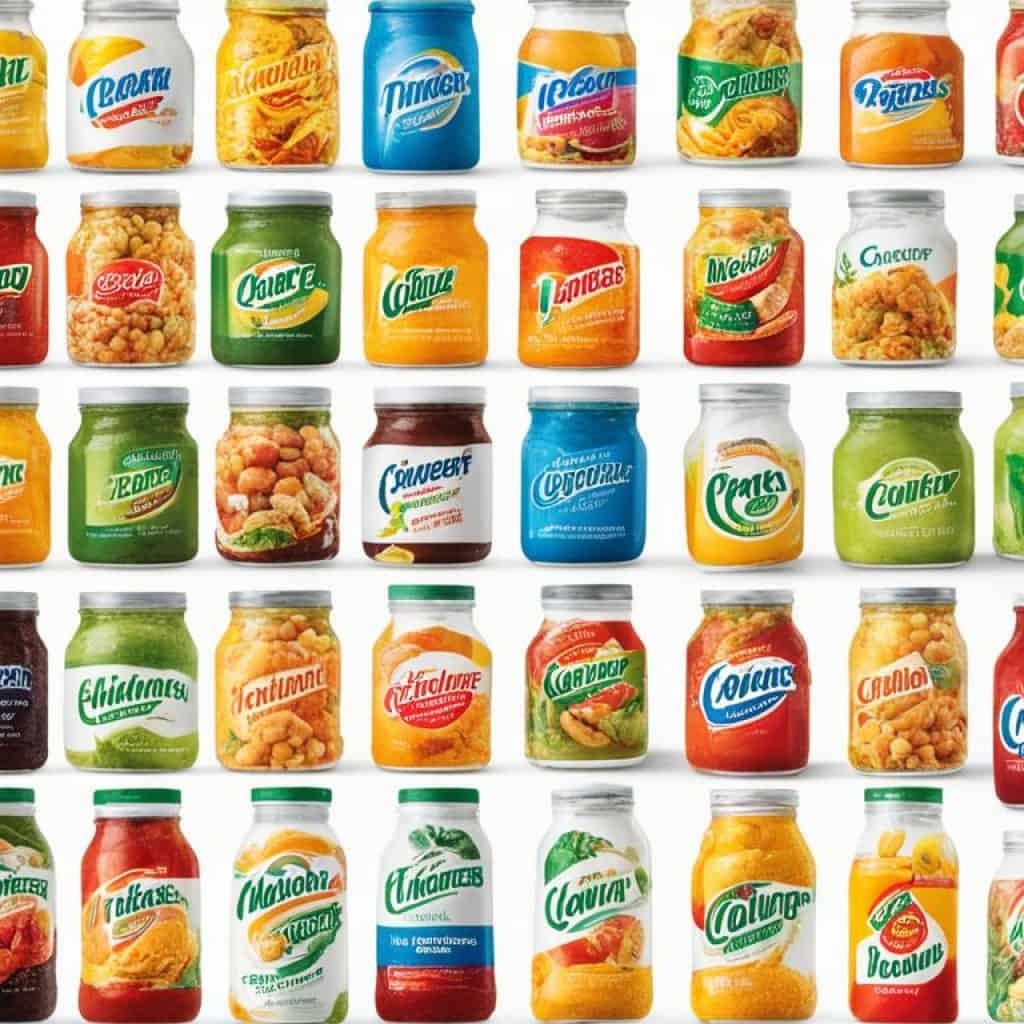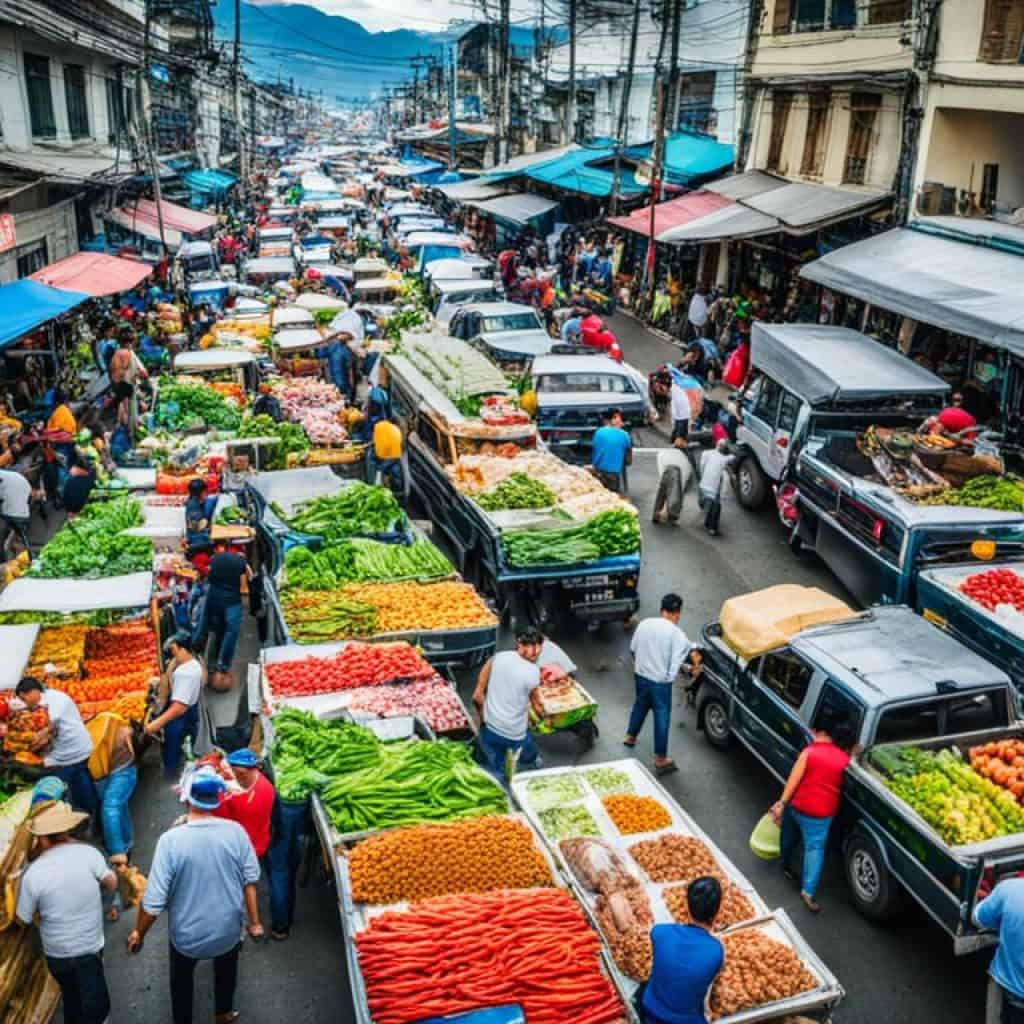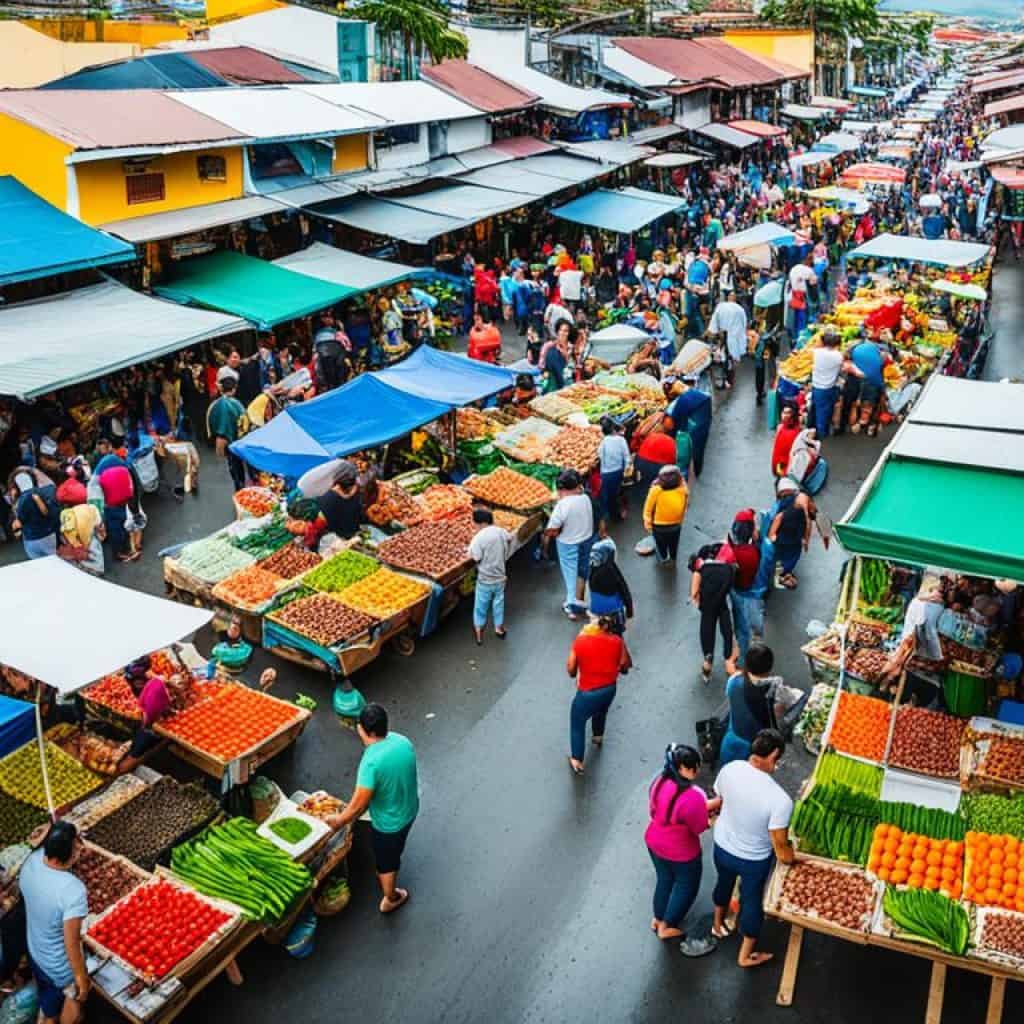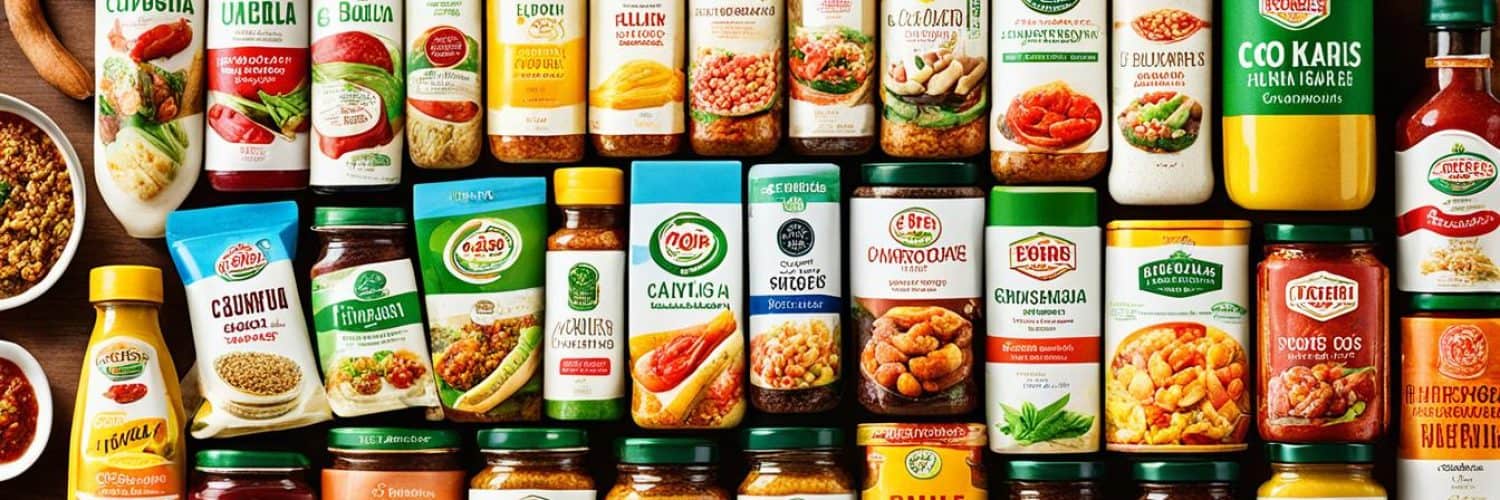What are the leading food companies in the Philippines? Have you ever wondered who the major players are in the Philippine food industry? Are you curious to know the top food manufacturers and distributors in the country? If so, you’ve come to the right place! In this guide, we will explore the vibrant and thriving world of the Philippine food industry and unveil the top food companies that are making waves in the market.
The Philippines is a powerhouse in the Asian food market, with the food and beverage sector playing a crucial role in the country’s economy. With increasing disposable income, favorable demographics, and urbanization, the demand for food products and services is on the rise. Whether you’re a food enthusiast, an aspiring entrepreneur, or simply interested in the Philippine food scene, this guide will provide valuable insights into the leading players shaping the industry.
Key Takeaways:
- Discover the major players in the Philippine food industry
- Learn about the growth trends and drivers in the F&B sector
- Understand the regulatory landscape for food companies in the Philippines
- Explore the market overview of food products in the country
- Gain insights into the gross value added in food manufacturing
Sector Overview
The food and beverage (F&B) industry in the Philippines is a rapidly growing sector and plays a significant role in the country’s economy. It is one of the biggest contributors to the nation’s economy, making up about half of its manufacturing sector and contributing about 23-24% to the country’s GDP. The Philippines is also one of the largest producers of food in Asia. In 2021, food products accounted for half of the gross value added generated from the manufacturing industry in the country.
The F&B industry includes food manufacturing and distribution, which contribute to the overall economic footprint of the agri-food sector.
Major Players in the Philippine Food Industry
The Philippine food industry boasts several major players and leading food companies that contribute to the sector’s growth and development. These companies have established their dominance and made a significant impact on the Philippine food landscape.
Jollibee Foods Corporation
Jollibee Foods Corporation is a major player in the Philippine fast-food industry, known for its extensive selection of local and international food brands. With a strong presence both domestically and internationally, Jollibee offers a wide range of flavorful and affordable meals that have captured the hearts and palates of Filipinos.
The Moment Group
Renowned for its diverse portfolio of F&B concepts, The Moment Group has made a name for itself in the Philippine food scene. From innovative and trendsetting restaurant concepts to culinary collaborations with renowned chefs, The Moment Group offers unique dining experiences that cater to a wide range of tastes and preferences.
Tasteless Food Group
Tasteless Food Group is a notable player in the Philippine food industry, showcasing unconventional and contemporary dining outlets that offer exciting and avant-garde culinary experiences. With a focus on creativity and pushing boundaries, Tasteless Food Group has carved a niche for itself by offering unique gastronomic adventures.
Max’s Group
Max’s Group is a prominent player in the Philippine food industry, known for its iconic and well-loved brands such as Max’s Restaurant, Pancake House, and Yellow Cab Pizza Co. With a strong presence in the casual dining segment, Max’s Group continues to captivate Filipino diners with their delicious food offerings and warm hospitality.
D&L Industries
D&L Industries is a key player in the Philippine food industry, specializing in food ingredients and raw materials. With a focus on providing high-quality products and innovative solutions, D&L Industries supports the growth and success of various food businesses in the Philippines.
Century Pacific Food
Century Pacific Food is a leading food company in the Philippines, specializing in canned protein products such as tuna, sardines, and corned beef. With a commitment to sustainability and product excellence, Century Pacific Food has established itself as a trusted provider of nutritious and flavorful food options.
Emperador Inc.
Emperador Inc. is a significant player in the Philippine food industry, specifically in the alcoholic beverages sector. With popular brands like Emperador Brandy, the company has solidified its position in the market and continues to innovate and expand its product offerings to cater to evolving consumer preferences.

These major players in the Philippine food industry exemplify the diversity, innovation, and excellence that the sector has to offer. Their contributions have shaped and continue to drive the growth of the Philippine food industry, making them essential pillars of the country’s culinary landscape.
Food Manufacturing Sector in the Philippines
The food manufacturing sector in the Philippines plays a vital role in the country’s economy, making a significant contribution to its GDP. In 2019, the F&B manufacturing industry accounted for € 53.4 billion in gross value added, highlighting its importance in the agri-food sector. This sector encompasses various product groups, driving growth and development within the food manufacturing industry.
Major Product Groups
The F&B processing industry in the Philippines focuses on several major product groups, each contributing to the overall success of the sector:
- Dairy products: This includes a wide range of products such as milk, cheese, butter, and yogurt.
- Vegetable and animal oils and fats: This category encompasses cooking oils, margarine, and other edible fats derived from both plants and animals.
- Meat products: From processed meats like sausages and hams to canned meats, this group covers various meat-based products.
- Prepared animal feeds: This sector is responsible for producing feeds for livestock, poultry, and other animals.
- Grain mill products: Flour, rice, and other grain-based products fall under this category.
- Fruits and vegetables: The Philippines is known for its abundant tropical fruits and vegetables, which contribute significantly to the food manufacturing sector.
- Fish and seafood: Given the country’s coastal location and rich marine resources, the production of fish and seafood plays a crucial role in the seafood processing industry.
- Other food products: This encompasses a wide range of food items such as snacks, confectionery, and canned goods.
These major product groups drive the growth and development of the food manufacturing sector in the Philippines, catering to both domestic and international markets.
The food manufacturing sector in the Philippines is diverse and dynamic, with various product groups contributing to its success. The production of dairy products, oils and fats, meat products, animal feeds, grain mill products, fruits and vegetables, fish and seafood, and other food products drives the growth of this sector, making it a vital component of the country’s agri-food industry.
F&B Distribution in the Philippines
F&B distribution plays a crucial role in the Philippine food industry, contributing significantly to the agri-food sector’s economic contribution. In 2019, F&B distribution contributed € 20.8 billion to the country’s GDP, with food retail being the largest component, accounting for € 14.2 billion. Other components of F&B distribution include food wholesale, catering, and accommodation. The distribution sector supports the supply chain and ensures that food products reach consumers efficiently.

Food retail is a major segment of F&B distribution in the Philippines. With a growing number of supermarkets, grocery stores, and convenience stores, food retail generates significant revenue and provides consumers with a wide range of options. Food wholesale, on the other hand, involves the distribution of food products in bulk to businesses such as restaurants, cafes, and hotels. This segment plays a crucial role in meeting the demand of the foodservice industry.
In addition to food retail and wholesale, the catering sector is an important component of F&B distribution. Catering companies provide food services for various events, including weddings, corporate gatherings, and parties. They play a vital role in ensuring high-quality food and excellent service for customers.
Accommodation establishments, such as hotels and resorts, also contribute to F&B distribution by providing food and beverage services to their guests. These establishments often have on-site restaurants, cafes, and bars that offer a range of dining options.
Overall, F&B distribution in the Philippines is a vibrant and dynamic sector that supports the growth of the food industry. By ensuring the efficient delivery of food products to consumers, it plays a crucial role in meeting the diverse needs and preferences of the Filipino market.
Growth Trends in the Philippine F&B Sector
The Philippine food and beverage (F&B) sector has been experiencing consistent growth in recent years, driven by a variety of factors. These growth trends demonstrate the potential and opportunities within the industry.
One of the key drivers of F&B sector growth in the Philippines is the increasing disposable income of the middle and upper classes. As people have more money to spend, they are more willing to explore diverse dining experiences and try new food products. This has led to a rise in demand for a wide range of F&B offerings.
In addition to increased disposable income, favorable demographics play a significant role in driving growth. The Philippines has a young and growing population, with a large proportion of the market consisting of young adults, who are generally more adventurous in their food choices. This demographic trend contributes to the growing demand for innovative and exciting F&B options.
The presence of retail and shopping centers also contributes to the growth of the F&B sector. These locations provide convenient access to a wide range of food and beverage options, making it easier for consumers to indulge in their culinary preferences. The availability of various F&B establishments in these centers creates a competitive environment that drives innovation and differentiation in the industry.
Furthermore, the rise in consumer spending on dining experiences has fueled the growth of the F&B sector in the Philippines. Consumers are now seeking more than just sustenance; they want memorable culinary experiences. This has led to the emergence of unique and specialized F&B concepts that cater to specific tastes and preferences.
The urbanization of the country has significantly contributed to the growth of F&B consumption. As more people migrate to urban areas, the demand for food and beverage services and products increases. Urban dwellers have a higher propensity to eat out and explore various F&B offerings, leading to a thriving industry in metropolitan areas.
| Trends Driving Growth in the Philippine F&B Sector: |
|---|
| Increasing Disposable Income |
| Favorable Demographics |
| Presence of Retail and Shopping Centers |
| Rise in Consumer Spending |
| Urbanization |
In conclusion, the Philippine F&B sector is witnessing promising growth trends driven by increasing disposable income, favorable demographics, retail and shopping centers, consumer spending, and urbanization. These trends present ample opportunities for businesses to thrive and innovate in the ever-evolving food and beverage industry.
Regulatory Landscape for Food Companies in the Philippines
Food companies in the Philippines operate within a regulatory landscape overseen by various government agencies. Two key entities responsible for ensuring the safety and quality of food products are the Food and Drug Administration (FDA) and the Department of Trade and Industry (DTI).
The FDA has the vital role of regulating the manufacture, importation, distribution, and sale of food products in the country. They enforce guidelines and standards to protect consumers from potentially harmful or substandard food items. The FDA’s oversight ensures that food companies adhere to rigorous manufacturing practices and maintain high-quality standards.
The DTI, on the other hand, formulates national standards for consumer products, including food. Their focus is to establish quality requirements and industry guidelines that uphold consumer safety and protect public health. By collaborating with industry stakeholders, the DTI helps facilitate fair trade practices and sets parameters for the food industry to follow.
Food companies in the Philippines must comply with specific regulatory requirements to operate legally. They are required to obtain a License to Operate (LTO) from the FDA, which validates their compliance with regulatory standards. This license ensures that the company has met all the necessary criteria to ensure safe food production and distribution.
Additionally, food companies are also required to secure a Certificate of Product Registration (CPR) from the FDA for each food product they offer in the market. The CPR serves as proof that the product has undergone evaluation and assessment by the FDA and has been deemed safe, effective, and of high quality.
Compliance with the regulatory landscape for food companies in the Philippines is essential for ensuring the safety and quality of food products available to consumers. It provides consumers with confidence in the food they consume and supports the growth and reputation of the Philippine food industry on a national and international scale.
| Regulatory Agencies | Responsibilities |
|---|---|
| Food and Drug Administration (FDA) | Regulates the manufacture, importation, distribution, and sale of food products |
| Department of Trade and Industry (DTI) | Formulates national standards for consumer products, including food |
Top Food Companies in the Philippines
The Philippine food industry is thriving, thanks to the presence of several top food companies that are leading the way in their respective segments. These companies play a crucial role in shaping the country’s culinary landscape and contributing to its economic growth.
Jollibee Foods Corporation
Jollibee Foods Corporation is a powerhouse in the fast-food industry, both locally and internationally. With a diverse portfolio of brands, including the iconic Jollibee, Chowking, Greenwich, and Red Ribbon, Jollibee Foods Corporation has become a household name in the Philippines. The company’s commitment to providing delicious and affordable meals has earned it a loyal following.
The Moment Group
The Moment Group stands out in the F&B industry with its innovative and unique concepts. This restaurant group is behind well-loved establishments such as 8Cuts Burgers, Manam, Ooma, and Din Tai Fung. The Moment Group’s commitment to culinary excellence and its ability to create memorable dining experiences have made it a top player in the Philippine food scene.
Tasteless Food Group
Tasteless Food Group is known for pushing the boundaries of traditional dining concepts. Under its umbrella are popular restaurants like Hole in the Wall, Bad Bird, Fowlbread, and Wrong Ramen. With its unconventional approach and dedication to culinary innovation, Tasteless Food Group continues to attract food enthusiasts looking for unique gastronomic experiences.
Max’s Group
Max’s Group is a leading player in the Philippine F&B industry, known for its iconic brand Max’s Restaurant, famous for its mouthwatering fried chicken. The company also operates other well-known restaurants such as Pancake House, Yellow Cab Pizza, and Krispy Kreme. Max’s Group’s commitment to authenticity and quality has established it as a trusted name in the food industry.
Emperador Inc.
Emperador Inc. is a powerhouse in the alcoholic beverage sector, particularly known for its brandy products. As one of the largest brandy producers in the world, Emperador Inc. has made a significant mark in the global market. The company’s commitment to craftsmanship and quality has earned it numerous prestigious awards.
D&L Industries
D&L Industries is a leading supplier of specialty food ingredients and colorants in the Philippines. The company’s wide range of products caters to various industries, including food manufacturing, personal care, and household products. D&L Industries’ commitment to innovation and sustainability has solidified its position as a key player in the food industry.
Century Pacific Food
Century Pacific Food is a major player in the food manufacturing industry, specializing in canned goods, processed meats, and dairy products. The company’s well-known brands include Century Tuna, Argentina, Angel, and Birch Tree. Century Pacific Food’s commitment to quality and value has made it a trusted choice for consumers.
These top food companies have taken the Philippine food industry to new heights, introducing innovative concepts, and shaping the culinary landscape. With their dedication to quality, creativity, and customer satisfaction, they continue to drive the growth and development of the Philippine food sector.
Market Overview of Food Products in the Philippines
The food market in the Philippines is a thriving sector, with various segments contributing to its growth. In 2022, the market revenue for food products is projected to reach €113,009m, solidifying its position as a lucrative industry in the country. Let’s take a closer look at the revenue figures for key segments within the Philippine food market:
Bread & Cereal Products
- Bread & Cereal Products hold the largest share in the market, with an estimated revenue of €XXXm in 2022.
- This segment encompasses a wide range of products such as bread, cereals, pasta, and other grain-based items.
- The demand for convenient and healthy options has fueled the growth of this segment, offering ample opportunities for producers and manufacturers.
Alcoholic Drinks Market
- The Alcoholic Drinks market is also a significant contributor to the overall food market revenue, projected to reach €11,650m in 2022.
- Spirits dominate this segment, reflecting the preferences and consumption patterns of consumers in the Philippines.
- This market offers prospects for both local and international beverage companies to showcase their products and cater to the diverse tastes of Filipino consumers.
Non-Alcoholic Drinks Market
- The Non-Alcoholic Drinks market is another substantial segment, with an estimated revenue of €13,267m in 2022.
- Soft Drinks hold the largest share within this market, offering a wide range of carbonated beverages, juices, and energy drinks.
- Consumer demand for refreshing and healthy beverage options has contributed to the growth of this segment, creating opportunities for both established brands and emerging players.
Hot Drinks Market
- The Hot Drinks market, which includes coffee, tea, and other hot beverages, is estimated to reach a revenue of €5,800m in 2022.
- Coffee is the dominant segment within this market, reflecting the Filipinos’ love for this caffeinated beverage.
- The popularity of premium coffee, specialty blends, and innovative brewing methods has fueled the growth of the hot drinks market in recent years.
The market overview of food products in the Philippines demonstrates the strong potential and growth opportunities within the sector. With a diverse range of segments and a growing consumer base, businesses in the food industry can capitalize on these favorable market conditions to thrive and succeed.

| Food Market Segment | Revenue (€) | Largest Segment |
|---|---|---|
| Bread & Cereal Products | XXXm | Bread & Cereal Products |
| Alcoholic Drinks Market | 11,650m | Spirits |
| Non-Alcoholic Drinks Market | 13,267m | Soft Drinks |
| Hot Drinks Market | 5,800m | Coffee |
Gross Value Added in Food Manufacturing in the Philippines
The gross value added in food manufacturing is a crucial measure of the economic impact of the sector in the Philippines. With the Philippines being one of the largest producers of food in Asia, the manufacture of food products significantly contributes to the country’s GDP.
The gross value added in food manufacturing, alongside other key contributing sectors, showcases the overall economic significance of the industry. It highlights the value created within the food manufacturing sector and reinforces its pivotal role in the Philippine economy.
By analyzing the gross value added in food manufacturing, policymakers, investors, and industry stakeholders can gain valuable insights into the growth and development of the sector. This data provides a comprehensive understanding of the economic contribution made by food manufacturing and its influence on the manufacturing industry in the Philippines.
To further comprehend the economic landscape of the food manufacturing sector in the Philippines, it is essential to explore specific indicators and statistics. These metrics offer a more detailed perspective on the performance and potential opportunities within the industry.
Key Indicators and Statistics
Let’s take a closer look at some important indicators and statistics that reflect the gross value added in food manufacturing.
| Year | Gross Value Added (PHP Billion) |
|---|---|
| 2017 | 450 |
| 2018 | 480 |
| 2019 | 520 |
| 2020 | 560 |
| 2021 | 610 |
The table above demonstrates the gradual increase in the gross value added in food manufacturing from 2017 to 2021. This upward trend signifies the sector’s consistent growth and its positive impact on the Philippine economy.
The image above further emphasizes the importance of the gross value added in food manufacturing in the Philippines. It visualizes the growth trajectory of the sector and reinforces its significant contribution to the country’s economy.
Conclusion
The food industry in the Philippines is thriving, fueled by a diverse range of food companies that contribute to its growth. From major players like Jollibee Foods Corporation and The Moment Group to smaller, specialized companies, the Philippine food industry offers a wide variety of choices for consumers. These companies constantly innovate and adapt to meet the changing demands of the market.
Several factors drive the growth of the food industry in the Philippines. The increasing disposable income of consumers, favorable demographics, and urbanization create a conducive environment for the sector’s expansion. As more people seek convenience and quality in their food choices, food companies have a wealth of opportunities to cater to these demands and thrive in the Philippine market.
For both local and international food companies, the Philippine food industry presents a promising market to explore. With a strong consumer base and a growing economy, businesses can establish their presence in the industry and tap into the country’s vast potential. By understanding the preferences and needs of Filipino consumers, food companies can provide innovative products and services that satisfy their cravings and enhance their dining experience.
FAQ
What is the significance of the food and beverage (F&B) sector in the Philippines?
How does the food manufacturing sector contribute to the Philippine economy?
What are some major players in the Philippine food industry?
What are the major product groups in the food manufacturing sector in the Philippines?
How does F&B distribution contribute to the Philippine food industry?
What are the growth drivers of the Philippine F&B sector?
What is the regulatory framework for food companies in the Philippines?
Who are some top food companies in the Philippines?
What is the market overview of food products in the Philippines?
How does the gross value added in food manufacturing contribute to the Philippine economy?
Source Links
- https://ambmanila.esteri.it/wp-content/uploads/2023/11/Philippines-Food-_-Beverage-F_B-Sector-Guide-final-1_compressed-2.pdf
- https://www.tatlerasia.com/dining/the-industry/restaurant-groups-in-the-ph-you-should-know
- https://www.slideshare.net/johnrheuvenbentulan/largest-food-and-beverage-companies-in-the-philippines


















Add comment